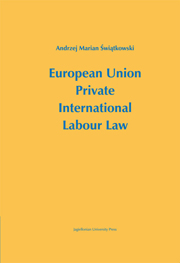Book contents
- Frontmatter
- Contents
- Introductory Comments
- Part I Preliminary Part
- Chapter 1 The subject of international private labour law
- Chapter 2 An attempt to erradicate any national labour law conflicts within EU private international labour regulations
- Part II Conflicts of law of individual labour law in the light of the Rome Convention of June 19, 1980 and Regulation of the European Parliament and the Council of the European Communities No. 593/2008 of June 17, 2008 on the law applicable to contractual obligations (“Rome I”)
- Part III Conflict of law issues in individual labour law in light of the Regulation (EC) No. 864/2007 of the European Parliament and the Council of the EU (July 11, 2007), concerning law applicable to Non-Contractual Obligations (“Rome II”)
- Part IV Conflicts of law in collective labour law
- Part V Conflicts of law in social security – the coordination of national social security systems of EU Member States according to the regulation of the European Parliament and Council Regulation (EC) No. 883/2004 of April 29, 2004 on the coordination of social security systems
- Part VI International procedural labour law of the European Union
- Selected bibliography
Chapter 2 - An attempt to erradicate any national labour law conflicts within EU private international labour regulations
from Part I - Preliminary Part
Published online by Cambridge University Press: 05 September 2014
- Frontmatter
- Contents
- Introductory Comments
- Part I Preliminary Part
- Chapter 1 The subject of international private labour law
- Chapter 2 An attempt to erradicate any national labour law conflicts within EU private international labour regulations
- Part II Conflicts of law of individual labour law in the light of the Rome Convention of June 19, 1980 and Regulation of the European Parliament and the Council of the European Communities No. 593/2008 of June 17, 2008 on the law applicable to contractual obligations (“Rome I”)
- Part III Conflict of law issues in individual labour law in light of the Regulation (EC) No. 864/2007 of the European Parliament and the Council of the EU (July 11, 2007), concerning law applicable to Non-Contractual Obligations (“Rome II”)
- Part IV Conflicts of law in collective labour law
- Part V Conflicts of law in social security – the coordination of national social security systems of EU Member States according to the regulation of the European Parliament and Council Regulation (EC) No. 883/2004 of April 29, 2004 on the coordination of social security systems
- Part VI International procedural labour law of the European Union
- Selected bibliography
Summary
With the exception of social security law, which includes separate standards coordinating national systems of social security law of the Member States of the European Union, the conflicts of substantive labour laws have been – and still are – regulated by internal and international rules of private international law. The need to adopt separate standards of private international labour law has been acknowledged by the institutions in a few years after the adoption of Regulation No. 1612/68, Council Directive No. 68/360 – international treaties, adopted on October 15, 1968, guaranteeing employees the freedom of movement within the then European Economic Community. In order to repeal the legal barriers to the free movement of persons within the common market on the June 14, 1971 Regulation No. 1408/71 was issued for coordinating national social security systems. The freedom of movement in order to take up employment under an employment relationship or business self-employment has increased with the adoption of directives to ensure the freedom of transferring capital to entrepreneurs, technology and staff within the common market within the economic freedom to provide services and the posting of workers to temporarily perform the work in another Member State. The Commission quickly recognised that the free movement of people (workers, employers, job seekers) between the borders of the Member States of the international regional organisation in Europe called the European Economic Community, leads to a situation whereby the local labour market (“intra-Community employment relationships”), located within the administrative borders of the Member States, in which different national systems of labour law relations exist, where employers are established in different Member States and the workers are nationals of various countries, are all governed by separate provisions of labour law.
- Type
- Chapter
- Information
- European Union Private International Labour Law , pp. 25 - 46Publisher: Jagiellonian University PressPrint publication year: 2012



